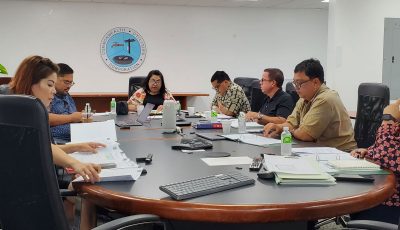Study: Only 8MW renewables can be inserted into grid
‘Perception that solar energy is cheaper is a myth’
A study commissioned by the Commonwealth Utilities Corp. bared that only eight megawatts of renewable energy can actually be inserted into the Saipan grid.
Citing the Renewable Energy Integration Study that was completed in December 2013, CUC executive director Alan Fletcher said the 8MW requirement also cannot be placed in one location alone and must be geographically dispersed.
Fletcher bared that the 8MW represents only about 5 percent of the annual energy requirements of Saipan. This means that CUC—assuming that it builds the 8MW solar energy—has to produce by 95 percent the remaining power needs of its customers using diesel.
If Saipan aims to have more than 8MW of renewable energy, this will require “ramp rate control” or large batteries and sophisticated electronics that are expensive to procure and maintain, Fletcher said.
In last week’s board meeting, CUC board chair David J. Sablan pointed out that many people have little understanding about how renewable energy works.
“There’s a lot of perception, especially in the community, that because the sun is always there and free, renewable energy should be cheaper. That is really a myth! Because the technology of harnessing the sun [or wind] power is very expensive,” said Sablan.
Compared to the present cost CUC incurs in producing power using diesel, inserting renewable energy into the grid will result in minimal savings, estimated at less than one penny at 20 percent penetration to the grid.
“If we were at 25 percent (renewable using solar energy), based on current pricing, it’s only one penny difference on the rate [we’re charging now,” said Fletcher, citing the study.
Each year, CUC spends between $65 million and $70 million for fuel to produce power. The goal of the agency, according to both the management and the board, is to look for cheaper fuel to reduce rates.
Geothermal energy
Fletcher disclosed that CUC has several initiatives in the works pursuant to the goal of meeting the 80 percent renewable energy goal for the CNMI as mandated by law.
Besides the federally funded renewable energy integration study, the agency is also looking forward to the completion of the Saipan Geothermal Resource Assessment, another federally funded initiative.
Fletcher said that CUC kicked off this project in 2011 but negotiations were halted a year after and the project was cancelled. In the fall of 2012, the CNMI conducted a rebid on the request for proposal and the same project was given back to CUC.
Fletcher said they are now in final negotiations with a potential contractor and a notice to proceed is expected to be issued next month.
“CUC received four proposals [for this feasibility study] and probably will take six weeks of drilling and a couple of months for logistics and mobilization [after the award]. So by the end of this year, we should have some results on this that we will bring to the board,” according to Fletcher.
‘Integrated Resource Plan’
A third initiative is the “Integrated Resource Plan,” which will create a roadmap for project identification and completion. It was disclosed that CUC received seven proposals for this study, of which four are large firms from the U.S. mainland.
“The plan will develop strategies to reduce fossil fuel dependency, while providing reliable generation at the least cost possible for consumers,” said Fletcher, adding that it will also review options for generation type and mix, system integrity and losses, conservation options, ownership, operating and financing options for CUC.
At present, an RFP for the project was closed last Feb. 26 and CUC is in the selection process with the help of experts.
Photovoltaic solar project
Meantime, the board has decided to put on hold CUC’s negotiation on a power purchase agreement for a photovoltaic solar project pending the completion of the geothermal study, which is vital in developing the RFP for the project.
Fletcher disclosed that this project was procured in 2012 and American Capital Energy was selected to do handle it.
However, discussions were held up as a result of competing power projects and assets being encumbered. Also a factor then was the need for further grid analysis.
He said discussions went back on track in late 2013 and it is presently finalizing the PPA.
“We recommend proceeding to negotiate down pricing and determine financial guarantees then we will report back to the board,” suggested Fletcher.
Saipan Tribune learned that if this PPA pushes through, the agreement is for 20 years.
“We need to wait until the geothermal feasibility is completed and depending on its outcome, we will then determine if we will proceed or not [with this PPA negotiation],” stated Sablan.



























